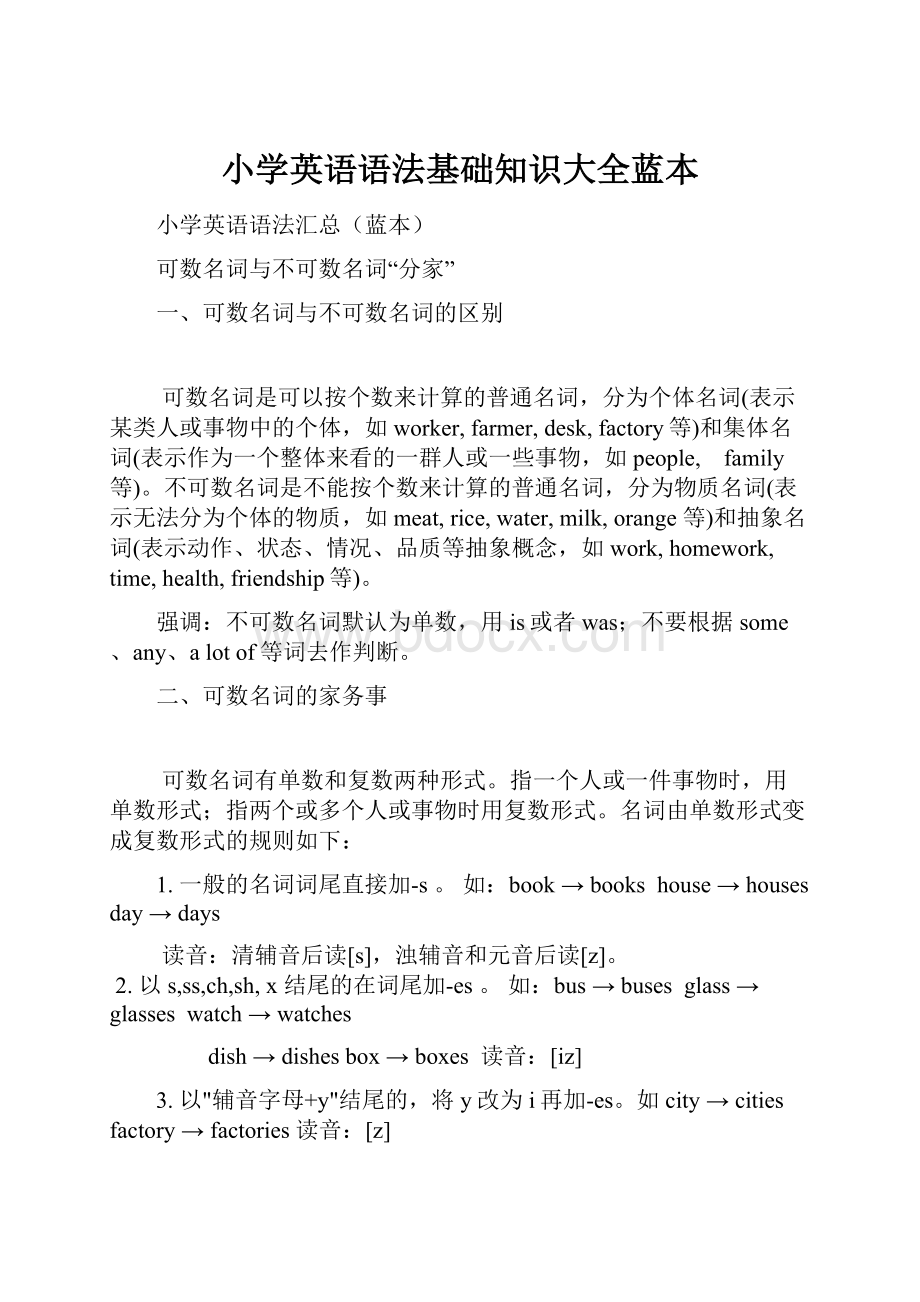小学英语语法基础知识大全蓝本.docx
《小学英语语法基础知识大全蓝本.docx》由会员分享,可在线阅读,更多相关《小学英语语法基础知识大全蓝本.docx(57页珍藏版)》请在冰豆网上搜索。

小学英语语法基础知识大全蓝本
小学英语语法汇总(蓝本)
可数名词与不可数名词“分家”
一、可数名词与不可数名词的区别
可数名词是可以按个数来计算的普通名词,分为个体名词(表示某类人或事物中的个体,如worker,farmer,desk,factory等)和集体名词(表示作为一个整体来看的一群人或一些事物,如people, family等)。
不可数名词是不能按个数来计算的普通名词,分为物质名词(表示无法分为个体的物质,如meat,rice,water,milk,orange等)和抽象名词(表示动作、状态、情况、品质等抽象概念,如work,homework,time,health,friendship等)。
强调:
不可数名词默认为单数,用is或者was;不要根据some、any、alotof等词去作判断。
二、可数名词的家务事
可数名词有单数和复数两种形式。
指一个人或一件事物时,用单数形式;指两个或多个人或事物时用复数形式。
名词由单数形式变成复数形式的规则如下:
1.一般的名词词尾直接加-s。
如:
book→bookshouse→housesday→days
读音:
清辅音后读[s],浊辅音和元音后读[z]。
2.以s,ss,ch,sh,x结尾的在词尾加-es。
如:
bus→busesglass→glasseswatch→watches
dish→dishesbox→boxes读音:
[iz]
3.以"辅音字母+y"结尾的,将y改为i再加-es。
如city→citiesfactory→factories读音:
[z]
4.以f或fe结尾的,将f或fe改为v再加-es。
如:
half→halvesleaf→leavesknife→knives
wife→wivesthief-thieves读音:
[z]
5.特例(常考)
①child→childrenmouse→mice
②man→menwoman→womenpoliceman→policemen(规律:
man→men)
③tomato→tomatoespotato→potatoes[注:
黑人英雄土豆西红柿加es其余加-s,,如:
photo→photos]
hero→heroesnegro→negroes读音:
[z]
④foot→feettooth→teeth[oo变ee]
⑤sheep,Chinese,Japanese,fish单、复数同形
⑥people单数形式表示复数意义,要求谓语动词用复数;people的复数形式peoples通常指"多个民族"。
三、不可数名词的家务事
1.不可数名词没有复数,作句子主语时,谓语动词用单数形式。
如:
Thefoodisveryfresh.
2.有的不可数名词也可以作可数名词,有复数形式,但意义发生变化。
如:
water(水)→waters(水域)
orange(橘汁)→oranges(橘子)
3.很多的不可数名词表示泛指时为不可数,表种类时就可数,意义不发生变化。
如:
fruit→fruits
food→foodsfish→fisheshair→hairs
4.计算不可数名词的数量,要在数词和不可数名词之间加上“量词+of”如:
aglassofwater
apieceofpaper
abottleofjuice
5.判断步骤:
↗如是am、is或was→原形
读句子→读该单词→认识该单词→理解意思→看be动词
↘如是are或were→加s或es
A.用所给名词的适当形式填空
1.Howmany________(sheep)arethereonthehill?
2.Thereissome________(food)inthebasket.
3.Thebabyhasonlytwo________(tooth)now.
4.Thereisalotof________(water)inthebottle.
5.Therearefive________(people)inhisfamily.
6.Let'stake________(photo),OK?
7.Ihavelotsof________(tomato)here.
8.The________(leaf)onthetreeturn-yellow.
9.The________(child)areplayinggamesontheplaygroundnow.
10.Their________(dictionary)looknew.
11.Iseeyouhaveafewwhite________(hair).
12.Theyare________(woman)doctors.
13.Canyougivemesomebottlesof____(orange),please?
14.Therearemany________(fox)inthepicture.
15.Iwouldlikesomeapple________(juice).Iamverythirsty.
16.Aretheretwo (box)onthetable?
17.Icanseesome (people)inthecinema.
18.Howmany (day)arethereinaweek?
19.Here’refive (bottle)of (juice)foryou.
20.This (violin)ishers.Those (grape)areoverthere.
参考答案:
1.sheep2.food3.teeth4.water5.people6.photos7.tomatoes8.leaves9.children10.dictionaries11.hair,hairs12.women13.orange14.foxes15.juice
B.写出下列各词的复数
I_________ him_________ this_______ her______ watch_______
child_______photo________diary______ day________ foot________
dress________tooth_______sheep______ box_______ strawberry_____
thief_____engineer____peach______ sandwich______ woman_______ leaf_______ people________
冠 词
冠词是一种虚词,不能独立使用,通常放在名词的前面,分为“不定冠词”和“定冠词”两种。
1、不定冠词:
a、an用在单数名词前,表“一个,一件……”。
an用在以元音“音素”开头的单词前。
如:
ane-mail,anorange,anoldman,anEnglishwatch,anhour
2、定冠词:
the用在单数或者复数名词前,没有具体意思,翻译为这、那。
基本用法:
(1)表特指某(些)人或某(些)事物。
如:
Themaponthewallisnew.
(2)表示说话者双方都知道的人或事物。
如:
Lookatthepicture,please.
(3)表示再次提到前面谈过的人或事物。
如:
Thisisastamp.Thestampisbeautiful.
(4)用在表示世界上独一无二的事物前。
如:
thesun太阳 themoon月亮 theearth地球
(5)用在由普通名词构成的专有名词前。
如:
theGreatWall长城
(6)用在江河、湖海等专有名词前。
如:
theChangJiangRiver长江
(7)序数词、形容词最高级、乐器等词前和一些习惯用语中一般都用定冠词the。
如:
thefirstday,thebestboy,playthepiano,inthesameclass
练一练:
1、用a或an填空。
____“U” ____ice-cream ____ goalkeeper ____teapot ____apple
____office ____Englishbook ____umbrella____unit ____hour
2、根据需要,填写冠词a,an或the。
(1)Whois ____girlbehind ____tree?
(2) ____oldmanhastwochildren, ____sonand ____daughter.
(3)Thisis ____orange. ____orangeisLucy’s.
(4)Helikesplaying ____guitar.Wehave ____samehobby.
(5)Weallhad____goodtimelastSunday.
(6)Shewantstobe____doctor.
数词
分为基数词和序数词。
基数用于表示数量多少,而基数词用于表示次序,常在日期中出现。
区别:
基数词前没有“the”;序数词前要有“the”。
1、超过二十以上的两位数需要在个位和十位之间加上“-”。
如:
21twenty-one
2、三位数以上的需在百位数后再加上and。
如:
101onehundredandone
3、基数词修饰可数名词时,别忘了其复数形式。
如:
十八个男孩 eighteenboys
4、基数词修饰不可数名词时,如是复数,变其量词为复数。
如:
两碗米饭 twobowlsofrice
5、序数词一般加“th”,特殊的:
first,second,third,fifth,eighth,ninth,twelfth
二十及二十以外的整十:
twentieth,thirtieth,fortieth…
“第几十几”:
前面整十不变,后面“几”改为序数词:
88 eighty-eighth
练一练:
1、请翻译下列短语。
(1)60名学生
(2)15本英语书
(3)九杯凉水 (4)4个孩子
(5)12月31 (6)6月2日
(7)第九周 (8)40年前
(9)11+7 (10)上学第一天
2、把下列基数词改成序数词。
one--- two--- three--- nine--- fourteen---
twenty--- thirty-five--- eighty-one
代 词
代词有两种:
人称代词和物主代词。
1、人称代词分为:
第一、第二、第三人称,且有单复数之分。
2、人称代词的主格做主语,用在动词前(疑问句除外);宾格做宾语,用于动词、介词后。
3、形容词性物主代词起形容词的作用,后面一定要跟名词,表示该名词是属于谁的。
4、名词性物主代词=形容词性物主代词+名词。
如:
Thisismybag.=Thisismine.
Thatisherruler.=Thatishers.
看后面有没有名词,如有,就用形容词性物主代词;如无,就用名词性物主代词。
牢记:
单数
复数
人称
代词
主格
I
you
he
she
it
we
you
they
宾格
me
you
him
her
it
us
you
them
物主
代词
形容词性
my
your
his
her
its
our
your
their
名词性
mine
yours
his
hers
its
ours
yours
theirs
练一练:
1.把表补充完整。
人称代词
物主代词
单数
复数
单数
复数
主格
宾格
主格
宾格
形容词性
名词性
形容词性
名词性
第一人称
me
us
our
第二人称
you
you
第三人称
he
them
his
their
her
it
its
2.用所给词的适当形式填空。
1)Thatisnot_________kite.Thatkiteisverysmall,but_________isverybig.(I)
2)Thedressis_________.Giveitto_________.(she)
3)Isthis_________watch?
(you)No,it’snot_________.(I)
4)_________ismybrother.________nameisJack.Look!
Thosestampsare_________.(he)
5)_________dressesarered.(we)Whatcolorare_________?
(you)
6)Show_________yourkite,OK?
(they)
7)Ihaveabeautifulcat._________nameisMimi.Thesecakesare_________.(it)
8)Arethese________tickets?
No,________arenot_________.________aren’there.(they)
9)Shall_________havealookatthatclassroom?
Thatis_________classroom.(we)
10)_________ismyaunt.Doyouknow_________job?
_________isanurse.(she)
11)Whereare_________?
Ican’tfind_________.Let’scall_________parents.(they)
12)Don’ttouch_________._________isnotacat,_________isatiger!
(it)
13)_________sisterisill.Pleasegoandsee_________.(she)
14)Thegirlbehind_________isourfriend.(she)
形容词、副词
1、形容词表某一事或人的特征,副词表示某一动作的特征。
形容词和副词有三种形式:
原形、比较级、最高级。
比较级:
+er 最高级:
the…+est
两个重要特征:
as……as中间一定用原形,than的前面一定要+er。
2、形容词、副词比较级的规则变化:
(1)直接+er。
如:
tall-taller,fast-faster 单音节词如果以-e结尾,只加-r。
如:
late-later
(2)重读闭音节词如末尾只有一个辅音字母,双写该字母,再加-er。
如:
big-bigger,fat-fatter
(3)以辅音字母加-y结尾的词,变y为i,再加-er。
如:
heavy-heavier,early-earlier
(4)双音节和多音节词的比较级应在原级前加more构成。
如:
beautiful-morebeautiful,
careful-morecareful,quietly-morequietly,interesting-moreinteresting
(5)不规则变化,须逐一记忆。
如:
good/well–better,bad/ill–worse,
many/much–more,far–farther/further,
old–older/elder
练一练:
A.写出下列形容词、副词的比较级。
big good long tall old
short thin heavy young fat
light strong high far low
early late well fast slow
B.用括号内所给单词的适当形式填空。
1)Icanswimas _______(fast)asthefish,Ithink.
2)Look!
Hishandsare _______ (big)thanmine.
3)Ithinkyoudothesethings_______(well)thanyourclassmates.
4)Whosebagis _______(heavy),yoursormine?
5)DoesJimrunas _______(slow)asDavid?
Yes,butMikeruns_______(slow)thanthem.
6)Youhavesevenbooks,butIhave _______(many)thanyou.Ihaveten.
7)Ijump _______(far)thansomeoftheboysinmyclass.
8)I’mvery_______(thin),butshe’s _______(thin)thanme.
9)Itgets _______and_______(warm)whenspringcomeshere.
介 词
1、一种虚词,不能单独作句子成分,只有跟它后面的宾语一起构成介词短语,才能起作用。
有:
in,on,under,with,behind,about,near,before,after,for,to,up,down,from,infront
of,outof,from…to…,atthebackof
2、表时间的有:
at,on,in
(1)at表“在某一个具体的时间点上”,或在固定词组中:
at9:
30a.m.,atnight,attheweekend…
(2)on表示“在某日或某日的时间段”:
onFriday,onthefirstofOctober,onMondaymorning…
(3)in表示“在某一段时间(月份、季节)里”:
intheafternoon,inSeptember,insummer,
in2005…
3、in还有其他的固搭:
inblue,inEnglish,takepartin
练一练:
1、选用括号内恰当的介词填空。
1)What’sthis _______(at,on,in)English?
2)Christmasis _______(at,on,in)the25thofDecember.
3)Theman_______(with,on,in)blackisSuHai’sfather.
4)Hedoesn’tdowell _______(at,on,in)PE.
5)Lookatthosebirds _______(on,in)thetree.
6)Wearegoingtomeet _______(at,on,in)thebusstop _______(at,on,in)halfpastten.
7)Isthereacat _______(under,behind,in)thedoor?
8)Helen’swritingpaperis _______(in,infrontof)hercomputer.
9)Welive _______(at,